Sassafras Tree: Leaves, Flowers, Bark (Pictures) – Identification Guide
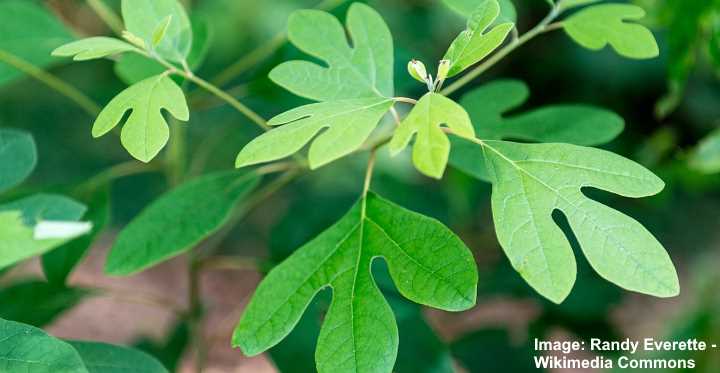
Sassafras is a group of deciduous trees with unusually lobed leaves, clusters of golden-yellow flowers, and dark blue berry-like drupes. Sassafras trees are also highly aromatic trees. In fall, when the foliage turns spectacular orange, scarlet, yellow, and purple colors, the leaves give off a strong fragrance. In the spring, the blossoms smell of root beer. Sassafras trees are relatively fast-growing trees, and the common Sassafras albidum matures at 30 to 60 ft. (9 – 18 m) tall and 25 to 40 ft. (7.6 – 12 m) wide.
Species of sassafras trees are relatively easy to identify in landscapes. The highly aromatic leaves give off a citrusy aroma and have distinct patterns. The sassafras leaves can be oval or lobed, with lobes numbering between two and five.
This article is a guide on how to identify species of native sassafras trees. Pictures and descriptions of sassafras leaves, bark, flowers, and fruit will help you recognize these attractive ornamental medium-sized trees.
Sassafras Tree Facts
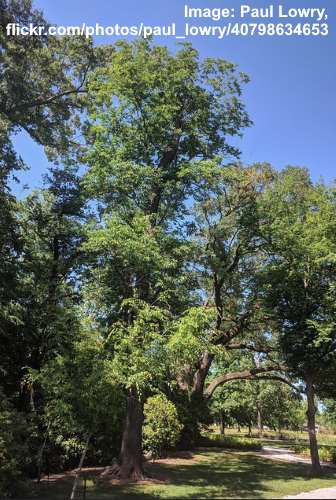
Sassafras tree
There are three species of sassafras native to North America and Asia—Sassafras albidum, Sassafras randaiense, and Sassafras tzumu. The common recognizable features of sassafras trees are their aromatic properties and unusually shaped leaves. However, the shrub-like tree also has suckering tendencies and can quickly become a large multi-stemmed shrub.
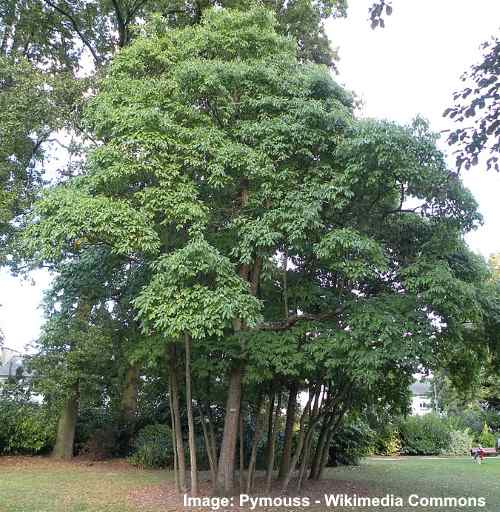
Sassafras albidum tree with multiple suckers
Sassafras trees thrive in USDA zones 4 to 9. The trees are commonly found on the east coast of the United States. They grow in open woodlands and well-drained soils from Rhode Island to the northern regions of Florida and east to Texas and Iowa.
Sassafras trees grow best in full sun to partial shade. In garden landscapes, sassafras trees thrive in well-drained, acidic soil. In ideal conditions, sassafras trees are fast-growing trees that grow between 12” and 24” (30 – 60 cm) a year. Sassafras albidum and Sassafras randaiense grow 30 to 60 ft. (9 – 18 m) tall. Sassafras tzumu is native to eastern Asia and grows up 115 ft. (35 m) tall.
Mature sassafras trees have a pyramidal or rounded crown. Because the sassafras tree’s taproots spread with suckers, the tree can grow into a large shrub. In open woodlands, it’s not unusual to see colonies of sassafras that are all connected to the same parent tree.
Sassafras Leaves
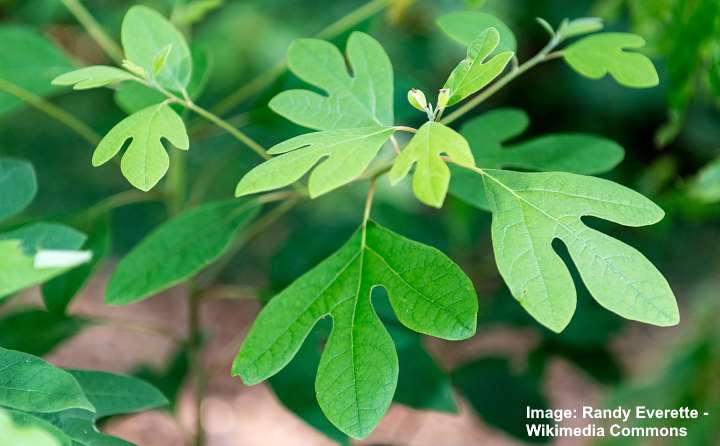
Sassafras leaves
Sassafras tree leaves are the easiest way to identify this deciduous tree. Sassafras leaves can be oval, mitten-shaped, and three-lobed. The medium-sized leaves grow between 3” and 7” (7.5 – 18 cm) and up to 4” (10 cm) wide. The yellow-green leaves emit a pungent citrus scent when crushed.
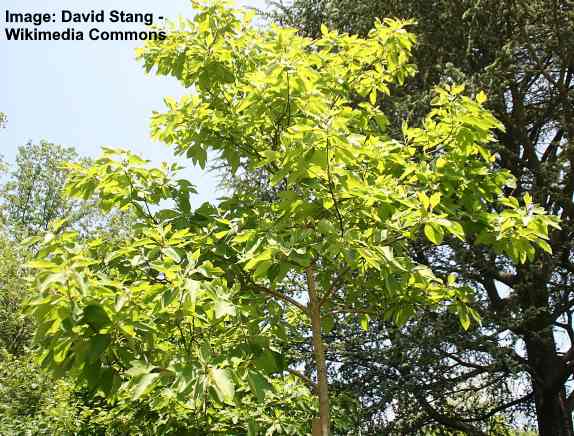
Sassafras albidum foliage
Sassafras trees have polymorphic leaves, meaning that a single tree can have leaves in different shapes. Three-lobed leaves are the most common leaf shape. However, some sassafras trees have five- or seven-lobed leaves.
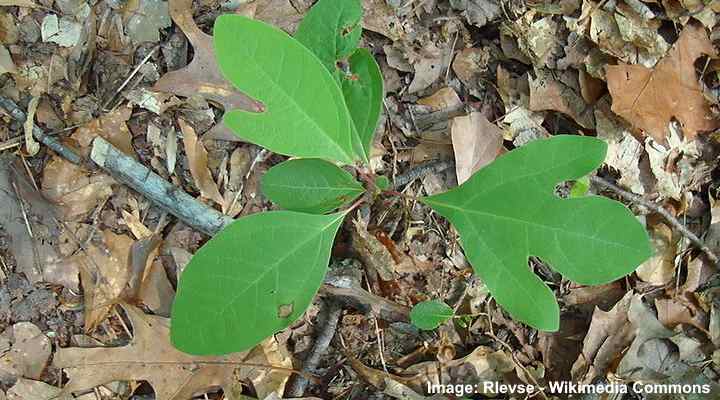
Sassafras leaf variations: unlobed, bilobed and trilobed
One reason to plant a sassafras tree in a garden landscape is for its fall colors. Before the leaves drop, the foliage turns spectacular showy shades of orange, red, yellow, and purple.
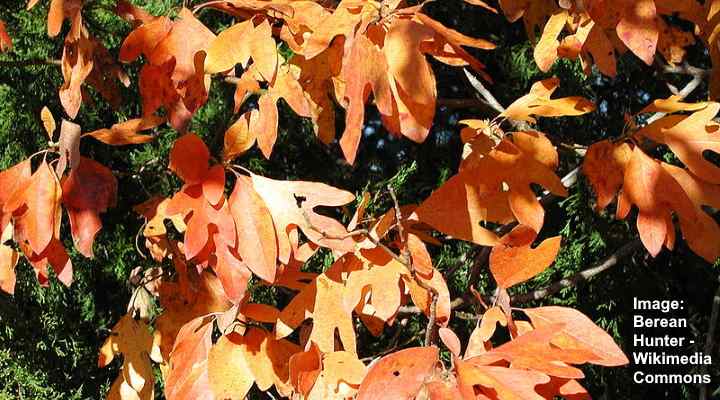
Sassafras autumn foliage
Sassafras Flowers

Close up images of Sassafras albidum female flowers (left) and male flowers (right)
Sassafras tree flowers have recognizable six-petaled, star-shaped yellow blossoms that measure 1” to 2” (2.5 – 5 cm) long. The greenish-yellow flower clusters appear at the ends of branch tips in early spring and persist for a few weeks. Pollinated female flowers develop into clusters of dark blue or black berry-like drupes.
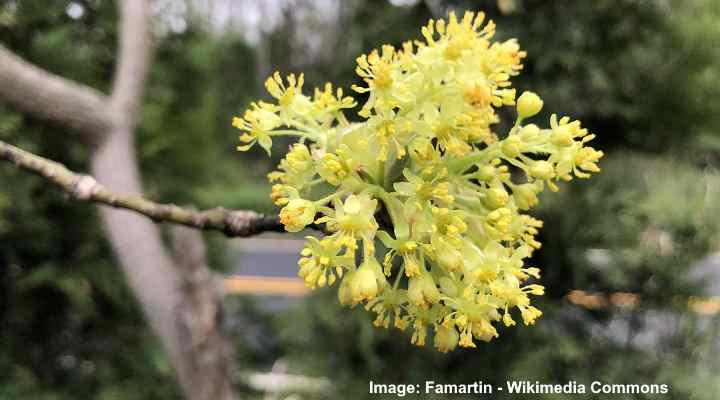
Sassafras flowers
Sassafras Bark
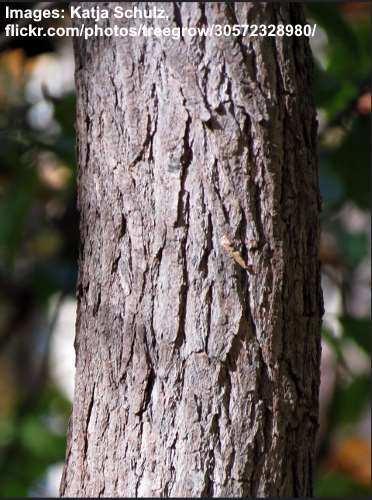
Sassafras bark
Sassafras tree bark is an attractive red-brown color that is smooth in immature trees and gradually develops interlacing furrows and ridges as it matures. Like other parts of the tree, the bark has a strong aromatic scent when cut. In winter landscapes, sassafras trees are identified by their attractive reddish-gray bark.
Sassafras Fruit
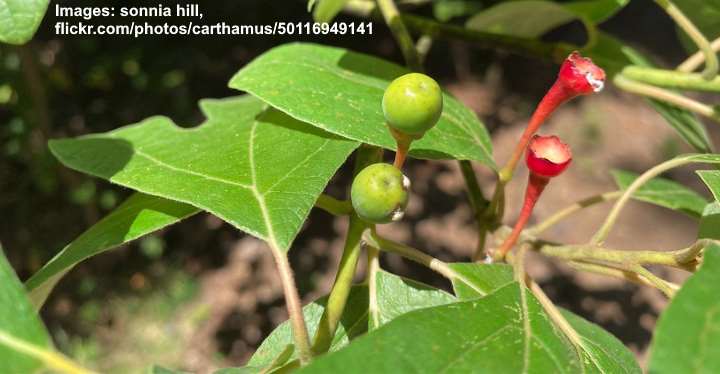
A close up picture of Sassafras green immature fruit. Blue-black drupes were on the red stems
Sassafras trees produce clusters of dark blue edible drupes, each containing a single seed. After flowering in spring, clusters of flowers give way to blackish-blue drupes contained in red cup-like receptacles. Sassafras fruit lasts on the tree during the summer. However, the tasty fruits are popular with deer, small mammals, and birds who are attracted to the tree for food.
Sassafras Seeds
Each blue sassafras drupe contains a single seed surrounded by pulpy flesh. Birds usually distribute the seeds. Sassafras seeds typically germinate the following spring after being planted in soil or landing on the ground. The ideal conditions for sassafras tree seeds to sprout are rich, loamy soil that is moist.
After seeds sprout in full sun, the tree grows rapidly and can grow 4 ft. (1.2 m) in the first year. Four years after germination, a sassafras tree measures around 15 ft. (4.5 m) tall. Unless the suckers are removed, and dense thicket will form a sassafras shrub.
Sassafras Tree Identification
Sassafras tree identification is by its characteristic aromatic leaves, yellow star-shaped flowers, and reddish-gray bark. The easily recognizable tree feature is the mitten-shaped or three-lobed green-yellowish leaves. You can also identify sassafras trees by crushing the leaves or cutting the bark to see if it exudes a strong lemony aroma.
If you notice differently shaped leaves on a tree, it is probably identified as a sassafras tree.
Where Sassafras Trees Grow
Sassafras trees grow in open woodlands where there is moist, well-drained loamy soil. The deciduous native trees are common throughout the central and eastern United States. You will often find sassafras trees growing near flowering dogwoods (Cornus florida), eastern red cedars (Juniperus virginiana), beech (Fagus grandifolia), and sugar maple trees (Acer saccharum).
What is Sassafras Used For?
Sassafras has many culinary uses and was commonly used in North American traditional medicine. Sassafras was the main ingredient of root beer and gave it its characteristic flavor. Crushed sassafras leaves are used to thicken gumbo and give Louisiana Creole cuisine its distinctive taste.
Since the 1960s, sassafras root oil is no longer used in the product of traditional root beer due to its potential carcinogenic properties. Studies found that safrole (which is a component found in sassafras oil) is linked to cancer, as well as kidney and liver problems. However, a 1997 study reported that herbal products derived from sassafras don’t contain any detectable amounts of safrole.
Safrole can harm people and pets if consumed in large enough amounts.
About Sassafras Albidum
Sassafras albidum is the most common species of sassafras tree in North America. The medium-sized deciduous tree also goes by the names white sassafras, red sassafras, or silky sassafras. Sassafras albidum grows 50 to 60 ft. (15 – 20 m) tall and has a pyramidal crown up to 40 ft. (12 m) wide.
Sassafras albidum is identified by the three leaf shapes—egg-shaped, two-lobed like mittens, and three-lobed leaves. The leaves have a pungent lemon scent when crushed. It’s rare to find leaves with more than three lobes growing on Sassafras albidum trees. In the fall, silky sassafras trees turn magnificent reds, pinks, oranges, and purples.
In early spring, bright yellow six-petaled flowers appear in drooping clusters. After blooming for two or three weeks, pollinated sassafras flowers develop into blackish-blue drupes that appear in dangling clusters.
Its aromatic, citrusy bark has deep furrows and is a reddish-brown color.
Growing Sassafras in a Container
Sassafras trees can grow well in containers on a patio, deck area, paved yard, balcony, or container garden. However, the size of the pot will limit the tree’s growth, and regular pruning will keep it growing like a small tree or shrub. To grow a potted sassafras tree, plant in fertile, well-drained soil, and place in bright, indirect sunlight.
To ensure the sassafras thrives in the potting soil, water whenever the top layer of soil feels dry. In addition, regular pruning in the spring can help create a bushier shrub-like tree. Although the sassafras plant is drought-tolerant, it performs better in moist but not soggy soil.
How to Care for Sassafras Trees
Let’s look in more detail at the best way to care for a sassafras tree in a garden landscape.
Where to Plant Sassafras Tree
The best place to plant a sassafras tree is in full sun to partial shade. Getting at least six hours of sunlight daily ensures that the foliage grows well, and the tree blooms every spring. Sassafras trees also adapt well to partial shade in balanced, loamy soil that provide excellent drainage.
Planting a sassafras tree in full sun is also vital to get the most vibrant fall colors.
As an easy-to-grow tree, sassafras trees perform well in most soil types. They will grow in clay, sandy soil, loam, and acidic soils. The essential care aspect for growing sassafras trees is excellent drainage. The taproots of the tree are prone to rot and decay if they grow in soggy conditions.
Sassafras trees grow best as a specimen or shade tree. However, you can allow suckers to grow if you want to have an informal hedge or summer privacy screen in your backyard.
How to Water Sassafras Tree
Sassafras trees require regular watering to keep the ground moist during spring and summer. It may be necessary to water the ground two or three times a week if the soil dries out. Also, immature sassafras trees require regular watering to help a robust root system develop.
Once established, sassafras trees are relatively drought-tolerant plants. To know when it’s time to water a sassafras tree in your garden, check the ground for moisture. If the soil seems damp, you can hold off watering for a couple of days. Then give the ground a deep soaking to ensure that the deepest roots are well hydrated.
As with many trees tolerant of drought, too much water can affect the plant’s growth. As a rule, only water the tree when the ground is dry. It’s usually not necessary to water the plant during winter.
Sassafras Tree Growing Zone, Temperature, and Humidity
Sassafras trees are cold-hardy trees that thrive in USDA zones 4 through 9 in full sun or partial shade. The strong, deep taproots withstand temperatures as low as -30°F (-34°C). Also, it is a good idea to ensure that the sassafras trees get protection from the wind.
To ensure that a sassafras tree survives winter, it’s essential to protect the root area with mulch. Spread a thick layer of wood mulch, pine needles, or a mulch alternative on the ground under the tree’s canopy. To prevent root rot, leave a 2” (5 cm) gap between the trunk and the mulch. Mulching ensures the ground doesn’t freeze down to the roots and prevents weeds from growing.
Sassafras trees also adapt well to high humidity. However, to prevent fungal foliage diseases, you should ensure plenty of air circulation between the leaves.
How to Plant Sassafras Tree
To plant a sassafras tree in your garden, choose the sunniest spot that has excellent drainage. Dig a hole three times the root ball diameter and slightly shallower than the root ball. Place the sassafras root ball in the hole, ensuring it is 1” (2.5 cm) above the soil line. Back-fill the remaining space and press down the soil as you fill the hole. Thoroughly water the site to remove any air pockets.
It’s good to note that transplanting an established sassafras tree is difficult due to its large, extensive taproot system.
Sassafras Tree Fertilization
Established sassafras trees require fertilization twice a year to encourage healthy foliage, plenty of flowers, and abundant fruits. You should apply a balanced, all-purpose fertilizer in February and then in mid-summer.
If you notice that the tree isn’t producing plenty of leaves, choose a high-nitrogen fertilizer to encourage dense leaf growth.
It’s always a good idea to test the soil for nutrient deficiencies before applying a specific fertilizer to target nitrogen, phosphorus, and potassium.
Related reading: The best tree fertilizers.
Pruning Sassafras Tree
It is rarely necessary to prune sassafras trees. However, cutting back branches in the winter of immature trees helps to promote a strong branch structure. With mature trees, remove dead and broken branches to keep the ornamental tree’s attractive appearance.
If you want to keep a sassafras tree shrub size, cut the stems back before winter to encourage bushy growth and control its height.
How to Propagate Sassafras Tree
The easiest and fastest way to propagate sassafras trees is by root cuttings. In early spring or winter, dig a hole about 12” (30 cm) in diameter and 20” (50 cm) deep near the base of the tree. Look for healthy roots that have at least one sprout from one of the roots. Then, using sharp pruning shears, cut a section 3” to 6” (7.5 – 15 cm) long.
After taking the root cuttings, place them in a container filled with sand and keep them moist. Once new growth appears, you can transplant the tree to your garden when the risk of frost has passed.
Another method of propagating sassafras trees is by harvesting, then germinating the seeds. Or you can try to find suckers far from the main tree as they have an independent root system. However, transplanting suckers is the least successful method of propagating a sassafras tree.
Pests and Diseases Affecting Sassafras Tree Growth
Sassafras are hardy trees that are typically resistant to pests. However, some pests that can affect a sassafras tree’s growth are large green silkmoth caterpillars, Japanese beetles, or sassafras weevils.
Because sassafras trees are a member of the laurel family Lauraceae, they can be affected by laurel wilt. This fungal infection occurs if redbay ambrosia beetles tunnel into the tree. The fungal infection causes severe disease and can end up killing a sassafras tree.
Overwatering can result in root rot and affect a sassafras tree’s growth. Signs that the tree is getting too much water or the ground drains poorly include yellowing leaves and a darkened band line around the soil line.
FAQs
Is Sassafras a good tree for gardens?
Sassafras trees are ornamental trees that enhance the aesthetics and features of a garden. All parts of the tree are aromatic and give off a pleasant citrus aroma. Additionally, the yellow flowers smell like root beer when in bloom.
A sassafras tree is ideal for gardens because it has seasonal interest throughout the year. In the summer, the large, unusually shaped leaves provide plenty of shade. When the leaves turn color in the fall, the sassafras tree becomes one of the most attractive trees in a garden due to its red, orange, purple, and yellow leaves. Then in winter, the sassafras tree’s gorgeous silhouette and reddish-gray bark provide plenty of visual interest.
Is Sassafras easy to grow?
Sassafras trees are easy to grow, and their surface root system and deep taproot don’t cause any problems for nearby structures. The tree grows reasonably rapidly at a rate of up to 2 ft. (0.6 m) per year and multiplies via suckers. Once established, sassafras trees are tolerant of drought, heat, cold, and humidity. It is not even necessary to prune the trees.
Related articles:
